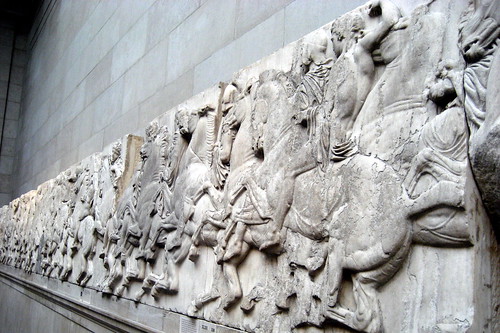Neil MacGregor, the director of the British Museum in
London, is also the author of A
History of the World in 100 Objects, a text used for our Objects of Travel
class. One specific chapter focuses on the hotly debated topic of the Elgin
Marbles. For those who have never heard of this debate, the Elgin marbles are
structures that Lord Elgin, the British Ambassador to the Ottoman Empire, took
around 1800 from the Parthenon. He then proceeded to put these marbles on
display in London, and they now find their home in the British Museum.
Other structures from the Parthenon are not only present in the British Museum, but in others such as
the Musee de Louvre in Paris. Here is actually a picture of these structures that I saw in the Louvre this past weekend, the exact
ones these articles refer to!
There are two sides to the story. The Greeks claim that Lord
Elgin actually stole the marbles because they claim the Sultan did not
officially approve Elgin’s removal of the marbles, and that this unofficial agreement from a
Turkish officer did not contain an agreement to take them out of the country. (3)
There is still much discord on this argument in particular. On the other hand, The
British Museum uses the marbles as an argument for their stance that they play
a leading role in allowing cultural identities to develop from the
interconnection of sculptures and artifacts from all over the world, allowing
the public (free of charge) to get a taste of the Greek culture. An article from the British Museum website states the importance of the arrival of these marbles in London because they “regenerat[ed] interest in ancient Greek culture and influence[ed] contemporary artistic trends.” (2)
In 2007, the Greeks finished construction on a much needed new
museum, the New Acropolis Museum, in an effort to prove they can care for their
structures and no longer need babysitting from the British Museum. Their
websites states “the new Museum offers all the amenities expected in an
international museum of the 21st century.” Thanks Greece, ‘bout time
you decided to catch up. (4)
I find myself agreeing with the British Museum’s side of the
debate, mainly because of the aftermath that would follow if the museum were to
return the marbles. Wouldn’t that then suggest that all artifacts should go
back to their original homes? This would obviously leave no need for museums
any longer and would lead to “a global loss of appreciation and understanding”
in the words of Tristram Hunt (1).
Even if Lord Elgin did in fact steal the marbles, I think
that at this point it would be more beneficial for the good of the museum
industry for the marbles to stay where they’re put, so long as they’re properly
preserved and given the rightful exhibition that they deserve.
An argument such as this holds such moral implications on
both sides that it seems like the two countries will never quite see eye to
eye. Give up the marbles and potentially give up the global connection of
cultural identification that is the very foundation of museums themselves? Or
live with the fact that the very artifacts the museum presents to the public eye
were acquired through deception and manipulation?
The man behind the drama. Just look at that smirk!
References:
(3) http://gogreece.about.com/od/museumsingreec1/i/marblereturn_2.htm
(4) http://www.theacropolismuseum.gr/en/content/museum-history






No comments:
Post a Comment